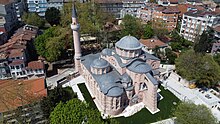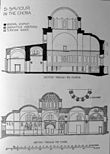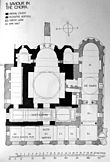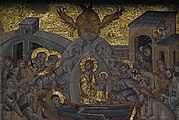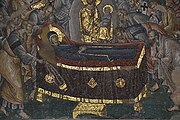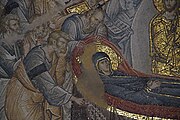|
Chora Church
  The Chora Church or Kariye Mosque (Turkish: Kariye Camii) is a former church, now converted to a mosque (for the second time), in the Edirnekapı neighborhood of Fatih district, Istanbul, Turkey. It is mainly famous for its outstanding Late Byzantine mosaics and frescos. The building is an example of Byzantine architecture. In the 16th century, during the Ottoman era, it was converted into a mosque; it became a museum in 1945, and was turned back into a mosque in 2020 by President Recep Tayyip Erdoğan.[1][2] The interior of the building is covered with some of the finest surviving Byzantine Christian mosaics and frescoes, which were left in plain sight during Muslim worship throughout much of the Ottoman era.[3] They were restored after the building was secularized and turned into a museum. The neighborhood is situated in the western part of the municipality of Fatih district. 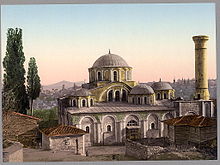  HistoryFirst phase (4th century)The Chora Church was originally built in the early 4th century as part of a monastery complex outside the city walls of Constantinople erected by Constantine the Great, to the south of the Golden Horn. However, when Theodosius II built his formidable land walls in 413–414, the church became incorporated within the city's defences, but retained the name Chora (for the presumed symbolism of the name see below). Second phase (11th century)The majority of the fabric of the current building dates from 1077–1081, when Maria Doukaina, the mother-in-law of Alexius I Comnenus, rebuilt the Chora Church as an inscribed cross or quincunx: a popular architectural style of the time. Early in the 12th century, the church suffered a partial collapse, perhaps due to an earthquake. Third phase: new decoration (14th century)The church was rebuilt by Isaac Comnenus, Alexius's third son. However, it was only after the third phase of building, two centuries after, that the church as it stands today was completed. The powerful Byzantine statesman Theodore Metochites endowed the church with many of its fine mosaics and frescoes. Theodore's impressive decoration of the interior was carried out between circa 1310 and 1317.[4] The mosaic-work is the finest example of the Palaeologian Renaissance. The artists remain unknown. A renowned classical scholar as well as statesman, Theodore donated his personal library to the Chora monastery, too.[5] In 1328, Theodore was sent into exile by the usurper Andronicus III Palaeologus. However, he was allowed to return to the city two years later, and lived out the last two years of his life as a monk in his Chora Church. Until the Conquest of ConstantinopleIn the late 13th and early 14th centuries, the monastery was home to the scholar Maximus Planudes, who was responsible for the restoration and reintroduction of Ptolemy's Geography to the Byzantines and, ultimately, to Renaissance Italy. During the last siege of Constantinople in 1453, the Icon of the Theotokos Hodegetria, considered the protector of the City, was brought to Chora in order to assist the defenders against the assault of the Ottomans.[6] Kariye Mosque (c. 1500–1945)Around fifty years after the fall of the city to the Ottomans, Hadım Ali Pasha, the Grand Vizier of Sultan Bayezid II, ordered the Chora Church to be converted into a mosque — Kariye Camii. The word Kariye derived from the Greek name Chora.[7] Due to the prohibition against iconic images in Islam, the mosaics and frescoes were covered behind a layer of plaster. This and frequent earthquakes in the region have taken their toll on the artwork. Museum, art restoration (1945–2020)In 1945, the building was designated a museum by the Turkish government.[8] In 1948, the American scholars Thomas Whittemore and Paul A. Underwood, from the Byzantine Institute of America and the Dumbarton Oaks Center for Byzantine Studies, sponsored a restoration program. From that time on, the building ceased to be a functioning mosque. In 1958, it was opened to the public as a museum, Kariye Müzesi. Reconversion to a mosque (2020–2024)In 2005, the Association of Permanent Foundations and Service to Historical Artifacts and Environment filed a lawsuit to challenge the status of the Chora Church as a museum.[9] In November 2019, the Turkish Council of State, Turkey's highest administrative court, ordered that it was to be reconverted to a mosque.[8] In August 2020, its status changed to a mosque.[10] The move to convert Chora Church into a mosque was condemned by the Greek Foreign Ministry and by Greek Orthodox and Protestant Christians.[1] This caused a sharp rebuke by Turkey.[11] On Friday 30 October 2020, Muslim prayers were held for the first time after 72 years.[12] The building was opened for Muslim worship on 6 May 2024.[13]
InteriorThe Chora Church is not as large as some of the other surviving Byzantine churches of Istanbul (it covers 742.5 m²) but it is unique among them, because of its almost completely still extant internal decoration. The building is divided into three main areas: the entrance hall or narthex, the main body of the church or nave, and the side chapel or parecclesion. The building has six domes: two above the esonarthex, one above the parecclesion and three above the naos.   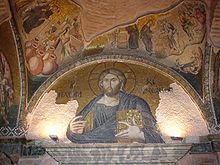  NarthexThe main, west door of the Chora Church opens into the narthex. It divides north–south into the outer, or exonarthex and the inner, or esonarthex. Exonarthex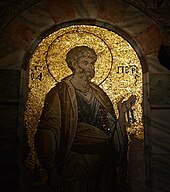 The exonarthex (or outer narthex) is the first part of the church that one enters. It is a transverse corridor, 4 m wide and 23 m long, which is partially open on its eastern length into the parallel esonarthex. The southern end of the exonarthex opens out through the esonarthex forming a western antechamber to the parecclesion. The mosaics that decorate the exonarthex include:
Esonarthex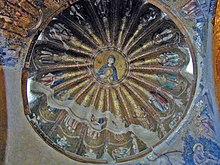 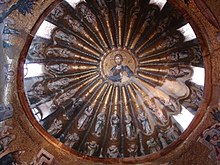 The esonarthex (or inner narthex) is similar to the exonarthex, running parallel to it. Like the exonarthex, the esonarthex is 4 m wide, but it is slightly shorter, 18 m long. Its central, eastern door opens into the naos, while another door at the southern end of the esonarthex opens into the rectangular antechamber of the parecclesion. At its northern end, a door from the esonarthex leads into a broad west–east corridor that runs along the northern side of the naos and into the prothesis. The esonarthex has two "pumpkin" domes. The smaller is above the entrance to the northern corridor; the larger is midway between the entrances into the naos and the pareclession, and they continue the emphasis on imagery of the Virgin and Christ seen elsewhere in these mosaics.[5]
The mosaics in the first three bays of the inner narthex give an account of the life of the Virgin, and those of her parents. Some of them are as follows:
NaosThe central doors of the esonarthex lead into the main body of the church, the naos. The largest dome in the church (7.7 m in diameter) is above the centre of the naos. Two smaller domes flank the modest apse: the northern dome is over the prothesis, which is linked by short passage to the bema; the southern dome is over the diaconicon, which is reached via the parecclesion. Only three mosaics survive in the Chora's naos:
Parecclesion To the right of the esonarthex, doors open into the side chapel, or parecclesion. The parecclesion was used as a mortuary chapel for family burials and memorials. The second largest dome (4.5 m diameter) in the church graces the centre of the roof of the parecclesion. A small passageway links the parecclesion directly into the naos, and off this passage can be found a small oratory and a storeroom. The parecclesion is covered in frescoes that emphasize the theological message of salvation, in keeping with the space's use as a funerary chapel.[5] Within the Christian worldview, God raises the dead at the end of time, hence the significance of the Anastasis and Last Judgement scenes painted prominently on the ceiling. The image of the Anastasis is particularly renowned, appearing in many art history survey books as a key examplar of late Byzantine art.
Along the walls of the Chora's parecclesion are arcosolia, arched recesses for tombs, likely intended for Theodore Metochites and his family. Also at this level are depictions of soldier saints, who wield swords as if protecting the tombs they accompany.[5]
NameThe original, 4th-century monastery containing the church was outside Constantinople's city walls. Literally translated, the church's full name was the Church of the Holy Saviour in the Country (Greek: ἡ Ἐκκλησία τοῦ Ἁγίου Σωτῆρος ἐν τῇ Χώρᾳ, hē Ekklēsia tou Hagiou Sōtēros en tēi Chōrāi). It is therefore sometimes incorrectly referred to as "Saint Saviour". However, "The Church of the Holy Redeemer in the Fields" would be a more natural rendering of the name in English. The last part of the Greek name, Chora, referring to its location originally outside of the walls, became the shortened name of the church. The name must have carried symbolic meaning, as the mosaics in the narthex describe Christ as the Land of the Living (ἡ Χώρα τῶν ζώντων, hē Chōra tōn zōntōn) and Mary, the mother of Jesus, as the Container of the Uncontainable (ἡ Χώρα τοῦ Ἀχωρήτου, hē Chōra tou Achōrētou). See also
Notes
References
Literature
External linksWikimedia Commons has media related to Kariye Mosque.
|
||||||||||||||||||||||||||||
